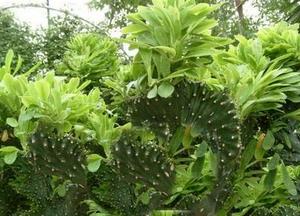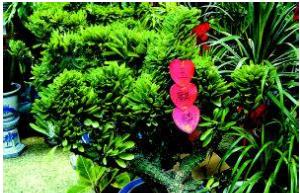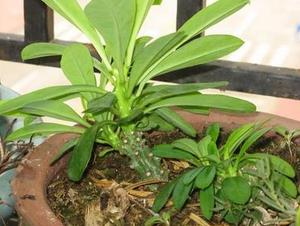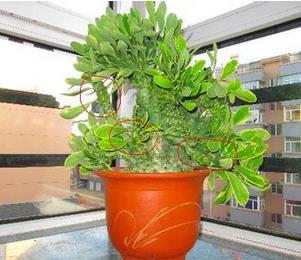Is it poisonous to grow Kirin palm at home? its breeding methods and matters needing attention
The unicorn palm is one of the more popular succulent plants, but if you put it in the courtyard and raise it, you need plenty of sunshine. Now I will introduce the planting method of the unicorn palm and its related knowledge.
First, unicorn palm

Kylin palm, native to the arid, hot and sunny areas of eastern India, is a variety of overlord whips. Qilin palm, also known as Kylin horn, is a perennial plant and a variety of Bawang whip. The abnormal stem is green at the initial stage, and then gradually lignified into yellowish-brown yellowish-like coarse branches, densely verrucose protuberances on the branches, dense leaves at the top of the stem and around, leaves Obovate, entire. Unicorn palm is a good indoor ornamental plant because of its peculiar shape and evergreen all the year round.
Second, the planting methods and matters needing attention of Kirin palm.
1, the light unicorn palm likes the light, after leaving the house at the beginning of May, first place under the shade shed for 7 to 10 days, and then put it in a sunny place for maintenance. Lack of light can easily cause abnormal stems to grow and become columnar stems. Especially in the growing season to ensure adequate light, must not stay indoors for a long time to watch. Although dormant in winter, the plant also needs to carry out photosynthesis to maintain basic life activities, so it should also be placed in a sunny place, otherwise it will make the leaves yellow and fall off.

2. Water Kylin palm is more drought-resistant, and usually watering is based on the principle that it would rather be dry than wet. When the basin soil is dry and hard and white, knock on the basin wall to hear the crisp sound of pouring water. Watering in winter is less than usual. In rooms with room temperature of 15 ℃ to 18 ℃, permeable water can be watered every 10 days or so. Too much watering is not only prone to atavism, but also lead to root asphyxiation.
3. Fertilizer Qilin palm does not like fertilizer very much, and the principle of fertilizer supply is that it is better to have less than more, and to be light rather than strong. The basin soil can be mixed with rotten leaf soil, coal cinder and garden soil, and less crushed solid fertilizer can be used as base fertilizer. About 15% fully mature alum fertilizer is applied once a month during the growing season. When fertilizing, avoid raw fertilizer, thick fertilizer, otherwise it is easy to cause rotten roots and fallen leaves. The fertilizer can be stopped when dormant in winter, and then gradually return to the normal level of fertilizer supply when it begins to grow in the next spring.

4. Temperature Kylin palm is not hardy. Generally speaking, you should enter the room before Frosts Descent's first cold spell in the future. At the beginning, we should pay attention to indoor ventilation and let it gradually adapt to the indoor microclimate. Even if it is warm in winter, you can't move outside to bask in the sun. If the room temperature can be kept above 15 ℃ in winter, the leaves will not fall; if the leaves have fallen, as long as the temperature is above 7 ℃, they can survive the winter safely. The leaves can be spread again in May of the following spring. It should be noted that unicorn palm is a poisonous flower.
5. The unicorn palm is propagated by the method of intercalation. From May to June, the sturdy abnormal stem was cut with a sharp knife to dry the mucus of the wound. Two or three days later, it was dipped in plant ash and then inserted into the moist river sandy soil, with a depth of 3 to 4 meters, compacted with hands and not watered. Water spraying is carried out after 2MUR for 3 days. Spraying water only needs to keep the sandy loam slightly moist. It can take root in about a month, and then it can be put on the basin.
Note: Qilin palms like drought, watering must not be too much, as long as the soil is slightly moist in summer. The palm of the unicorn is not cold-resistant, and the north should move indoors or into the greenhouse before Frosts Descent in mid-October. When the winter temperature is low, the basin soil remains dry. As long as the room temperature is kept above 15 degrees, the leaves will not turn yellow, but below 12 degrees, the leaves will dry up and fall off. Change the basin once every 1-2 years. Remove the old soil and remove the decaying roots when changing the basin. Keep the soil moist after changing the basin, keep it indoors for about ten days, and then move out of the room.

Note 1, light unicorn palm happy light, after leaving the house in early May, first put under the shade shed for 7 to 10 days, and then put it in a sunny place for maintenance. Lack of light can easily cause abnormal stems to grow and become columnar stems. Especially in the growing season to ensure adequate light, must not stay indoors for a long time to watch. Although dormant in winter, the plant also needs to carry out photosynthesis to maintain basic life activities, so it should also be placed in a sunny place, otherwise it will make the leaves yellow and fall off.
Note 2, water Kylin palm is more drought-resistant, usually watering to dry rather than wet as the principle. When the basin soil is dry and hard and white, knock on the basin wall to hear the crisp sound of pouring water. Watering in winter is less than usual. In rooms with room temperature of 15 ℃ to 18 ℃, permeable water can be watered every 10 days or so. Too much watering is not only prone to atavism, but also lead to root asphyxiation.

And then the light. Qilin palm happy light, after leaving the house in early May, first put under the shade shed for 7 to 10 days, and then put in a sunny place for maintenance. Lack of light can easily cause abnormal stems to grow and become columnar stems. Especially in the growing season to ensure adequate light, must not stay indoors for a long time to watch. Although dormant in winter, the plant also needs to carry out photosynthesis to maintain basic life activities, so it should also be placed in a sunny place, otherwise it will make the leaves yellow and fall off.
Third, what if the leaves of the unicorn palm turn yellow?
First of all, temperature. The palm of the unicorn is not hardy, so Frosts Descent usually moves indoors in the middle of October. When the room temperature was kept above 15 ℃, the leaves would not turn yellow, but the leaves would dry up and fall off below 12 ℃. When the room temperature is above 6 ℃, the potted soil is relatively dry, and the palm of the unicorn will not freeze, and new leaves will still come out the following year. The basin is changed every 1 / 2 years. The unicorn palm is native to the tropics and enjoys a warm, humid and sunny environment. Summer and autumn is the peak growth period, it should be placed in a semi-shaded place to avoid bright light throughout the day. It can withstand drought, watering less rather than more, watering every two or three days. It can be suitable to chase the hedge dilute liquid fertilizer during the growing period.
Secondly, moisture. The palm of the unicorn is more drought-tolerant and is usually watered on the principle that it would rather be dry than wet. When the basin soil is dry and hard and white, knock on the basin wall to hear the crisp sound of pouring water. Watering in winter is less than usual. In rooms with room temperature of 15 ℃ to 18 ℃, permeable water can be watered every 10 days or so. Too much watering is not only prone to atavism, but also lead to root asphyxiation.

Fourth, is it poisonous to grow unicorn palm at home?
There are many rumors about carcinogenic plants on the Internet, there are also rumors of various poisonous plants, and there is also a list of anti-cancer plants. Flower lovers should not be intimidated or superstitious about radiation prevention and cancer prevention. First of all, the unicorn palm is a common ornamental plant, and its juice is milky white and poisonous (this is common sense). In real life, if you come into contact with the white juice of the unicorn palm, you should wash it in time. At present, many flower friends have unicorn palm at home. I have not heard of who has been poisoned, and the unicorn palm itself will not emit any carcinogenic smell, so flower friends can rest assured that the juice of the unicorn palm is toxic to a certain extent. Just pay more attention to it at ordinary times. If you have children at home, you should tell them not to cut and touch the unicorn's palm casually. Watering in winter is less than usual. In rooms with room temperature of 15 ℃ to 18 ℃, permeable water can be watered every 10 days or so. Too much watering is not only prone to atavism, but also lead to root asphyxiation.

And then the light. Qilin palm happy light, after leaving the house in early May, first put under the shade shed for 7 to 10 days, and then put in a sunny place for maintenance. Lack of light can easily cause abnormal stems to grow and become columnar stems. Especially in the growing season to ensure adequate light, must not stay indoors for a long time to watch. Although dormant in winter, the plant also needs to carry out photosynthesis to maintain basic life activities, so it should also be placed in a sunny place, otherwise it will make the leaves yellow and fall off.
Third, what if the leaves of the unicorn palm turn yellow?
First of all, temperature. The palm of the unicorn is not hardy, so Frosts Descent usually moves indoors in the middle of October. When the room temperature was kept above 15 ℃, the leaves would not turn yellow, but the leaves would dry up and fall off below 12 ℃. When the room temperature is above 6 ℃, the potted soil is relatively dry, and the palm of the unicorn will not freeze, and new leaves will still come out the following year. The basin is changed every 1 / 2 years. The unicorn palm is native to the tropics and enjoys a warm, humid and sunny environment. Summer and autumn is the peak growth period, it should be placed in a semi-shaded place to avoid bright light throughout the day. It can withstand drought, watering less rather than more, watering every two or three days. It can be suitable to chase the hedge dilute liquid fertilizer during the growing period.
Secondly, moisture. The palm of the unicorn is more drought-tolerant and is usually watered on the principle that it would rather be dry than wet. When the basin soil is dry and hard and white, knock on the basin wall to hear the crisp sound of pouring water. Watering in winter is less than usual. In rooms with room temperature of 15 ℃ to 18 ℃, permeable water can be watered every 10 days or so. Too much watering is not only prone to atavism, but also lead to root asphyxiation.

Fourth, is it poisonous to grow unicorn palm at home?
There are many rumors about carcinogenic plants on the Internet, there are also rumors of various poisonous plants, and there is also a list of anti-cancer plants. Flower lovers should not be intimidated or superstitious about radiation prevention and cancer prevention. First of all, the unicorn palm is a common ornamental plant, and its juice is milky white and poisonous (this is common sense). In real life, if you come into contact with the white juice of the unicorn palm, you should wash it in time. At present, many flower friends have unicorn palm at home. I have not heard of who has been poisoned, and the unicorn palm itself will not emit any carcinogenic smell, so flower friends can rest assured that the juice of the unicorn palm is toxic to a certain extent. Just pay more attention to it at ordinary times. If you have children at home, you should tell them not to cut and touch the unicorn's palm casually.
Related
- Wuhan Hospital Iron Tree Blooming Result Was Instantly Frightened by the Gardener Master
- Which variety of camellia is the most fragrant and best? Which one do you like best?
- What is the small blue coat, the breeding methods and matters needing attention of the succulent plant
- Dormancy time and maintenance management of succulent plants during dormancy
- Minas succulent how to raise, Minas succulent plant pictures
- What are the varieties of winter succulent plants
- How to raise succulent plants in twelve rolls? let's take a look at some experience of breeding twelve rolls.
- Attention should be paid to water control for succulent plants during dormant period (winter and summer)
- Watering experience of twelve rolls of succulent plants
- Techniques for fertilizing succulent plants. An article will let you know how to fertilize succulent plants.



